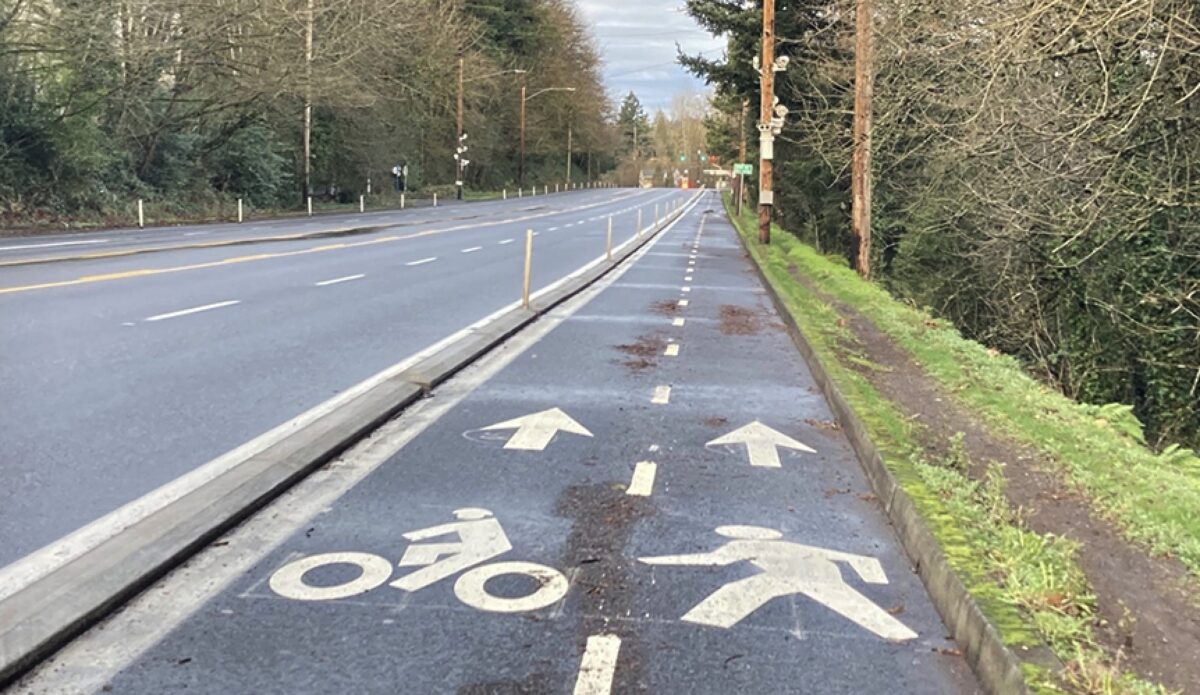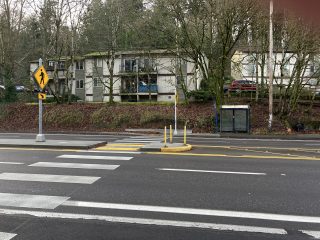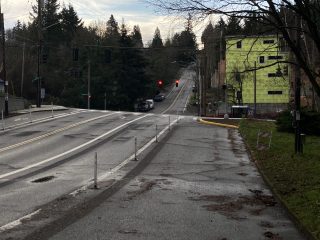
Traffic safety-related changes near the Hillsdale town center have reached a critical mass; this corridor feels calmer than it used to, and the numbers support the perception.
With its crash reduction numbers and positive safety trends, Hillsdale and PBOT make a case for the effectiveness of persistent incrementalism.
The Portland Bureau of Transportation (PBOT) has been gradually making changes in the area over the past several years, but it is easy for gradual change to go unnoticed, particularly when it’s incremental improvement—no fanfare, no ribbon-cutting, just a steady build-up of small fixes. So I thought I would sing the song of incrementalism, as it has played out near Hillsdale.
First came the speed cameras, located on the 3600 block of Beaverton-Hillsdale Highway. These were Portland’s very first fixed speed safety cameras and they were installed in August 2016 as part of an eight-camera pilot program. The results were immediate and profound. The percentage of Hillsdale-bound drivers exceeding the 40 mph speed limit decreased from 77% to 30%. But even more dramatic was the drop in drivers traveling over 50 mph; it fell by 93%, from 7.7% to 0.5%.
Advertisement
At a recent Southwest Neighborhoods Inc Transportation Committee meeting, Clay Veka, PBOT’s manager of High Crash Corridor safety programs, pointed out that PBOT twice narrowed Beaverton-Hillsdale travel lanes in the years before and after the camera installation. These narrower travel lanes might also contribute to traffic calming and could be confounding the safety effect of the camera, “I’m not sure how to parse out the effects,” Veka said.

That point is well-taken and would particularly apply to crash data. But over the years PBOT has also regularly taken speed readings from a pneumatic tube they locate about 450-feet east of the eastbound camera. It is notable that one-and-a-half football fields past the camera slower driving speeds persist. In fact, I calculated the impressive speed reductions cited above from that same distant tube.
The second of the lane width reductions Veka referred to came in 2019, when PBOT launched its Beaverton-Hillsdale Highway Safety Demonstration Project between 39th Ave and Dosch/30th Ave. The Demonstration Project included further widening the 2013 buffered bike lane to include a pedestrian track and raised curb protection with candles (top photo). As part of the same project, PBOT installed a pedestrian refuge island with a flashing beacon near SW 35th Ave, and new ADA ramps.
Advertisement
The project wrapped up just a few months ago with the curb extension at SW Dosch Rd, and the removal of Dosch’s right-turn lane onto Beaverton-Hillsdale Highway. The speed limit has also been lowered to 35 mph from 40.

Excuse the pun, but some of this is pretty pedestrian stuff, boring even. These needs have been identified by many PBOT plans through the years, like the PedPDX and Southwest in Motion processes, and the High Crash Corridor Safety Plan, among others.
And yet, after this interminable planning, PBOT does seem to have arrived at safety. Last month, they reported a 30% reduction in crashes resulting in serious injury or death since the installation of the speed cameras. 30% is a big deal.
There have also been other changes in the area, with more to come, like the Red Electric bridge and possibly a Rose Lane. But my favorite improvement is the left-turn calming noses at the intersection of SW Sunset Blvd and Capitol Highway. The noses are part of the 2019 Left-turn Calming Pilot Project under Vision Zero.

The idea behind the noses is that they protect people in crosswalks by nudging left-turning drivers into making a safer crosswalk approach. No longer able to easily cut the corner, drivers are forced to both slow down and meet the crosswalk straight-on, which makes it easier for the driver to see a person walking. The program successfully met its evaluation criteria and PBOT announced in January that they haven’t had any pedestrian deaths at the pilot intersections.
While I was studying the noses, Joe Minato joined me. Minato is a science teacher at Ida B. Wells High School (formerly Wilson High) and he usually commutes to work by bus or bicycle. He told me he “was thrilled” when he saw the noses and called them “an elegant and inexpensive solution,” adding that “as a citizen and a taxpayer” he appreciated their effective and low-cost design. Later I learned that the left-turn calming project was paid for by our recreational cannabis tax; I’m 100% certain that no Minato tax monies contributed to that program.
The Hillsdale area seems to have benefited from the synergy between a number of PBOT initiatives with various funding streams. It is not possible years later to tease apart their effects and assign safety credits, nor can PBOT afford a well-controlled study of every incremental improvement it makes. But with its crash reduction numbers and positive safety trends, Hillsdale and PBOT make a case for the effectiveness of persistent incrementalism.
— Lisa Caballero, lisacaballero853@gmail.com
— Get our headlines delivered to your inbox.
— Support this independent community media outlet with a one-time contribution or monthly subscription.


